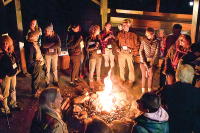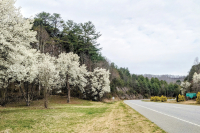Residents value rural heritage and environment in highway debate
An overwhelming majority of citizens who showed up at a public hearing in Robbinsville spoke out against the Corridor K road project last Thursday (Oct. 29).
The proposed four-lane highway would supplant the winding, two-lane roads that are currently the only means of access to Graham County. In the process, it would bore a half-mile long tunnel — the longest in the state — through a mountain. It would also tower over the rural Stecoah Valley area.
Corridor K, a 127-mile route through the mountains of Tennessee and North Carolina, has been in the works for more than three decades. The DOT wants to start construction by 2014 on a 10-mile section of the 17-mile missing link in Graham County.
The road’s three goals are to bring economic development, end a geographic isolation N.C. DOT sees as dangerous, and improve steep and curvy roads that currently feature inadequate shoulders.
The highway would take the thousands of tractor-trailers out of the Nantahala Gorge, which is currently the main artery to reach Murphy but is clogged with buses loaded with rafters and kayakers.
David Monteith, a Swain County commissioner, said the new highway would increase tourism in Swain County, bringing more people in to raft the Nantahala and ride the train.
“It would bring in more people to Western North Carolina, period,” said Monteith.
But only two of the 22 speakers at the N.C. Department of Transportation hearing piped up in favor of the road. The rest enumerated every conceivable reason for why the road has no place in Graham County.
Bob Grove said the proposed roadway would not help Graham County’s economy. It would more likely provide easy access to a big-box chain stores like Wal-Mart than to downtown stores. For Grove, the highway provides an open invitation to local residents to head out of town to do their shopping.
Grove and many others suggested that it would be far less expensive and less destructive to improve the existing roads, rather than build a highway that would destroy the town’s main draw for tourists: scenic, winding two-lane roads.
Tom Hoffman of Virginia said he might stop coming to Graham County if the highway is built and that he would not return to “ooh and aah at a freeway interchange.”
Many voiced concerns about Robbinsville losing its rural character and transforming into yet another American “Clonesville,” with strip malls, billboards and fast-food chains lining the streets.
Others who objected said second home owners, who would surely come with the highway, would jack up tax values and drive out today’s local residents.
“It’s a euphemistic thing to be calling it economic development,” said Brian Rau of Stecoah. “To me, it’s just plain development.”
The issue hit close to home for Guy Roberts, who would lose the property that’s been in his family for five generations and more than a hundred years.
“We would like to preserve what is there for future generations,” said Roberts’ son-in-law Jeff Phillips. “I want to be able to fish with my grandchildren and have horses and cows they can play with. I want to be there for the rest of my life.”
A telling example of Graham County’s position came at two points in the night. Nearly everybody raised their hands when asked if they were against the road. When Melbe Millsaps asked who actually worked in Graham County, only a handful went up.
Millsaps said even though Corridor K would cut through her property, it would also provide more jobs and better access to education and healthcare for Graham County. Millsaps said she knows how dangerous the roads there can be after being forced to commute two hours each way to get to her nursing school.
“I think it’s time for Graham County to move into the 21st century and build the road,” Millsaps said.
Denny Mobbs, who lives in Ocoee, Tenn., agreed and said it’s time to bring some development into Graham County.
“We don’t want a pristine impoverishment,” said Mobbs.
Others worried about the road’s environmental impact, including air, noise and water pollution. The tunnel, which would be a major expense of the project, avoids the Appalachian Trail by going under it.
Melanie Mayes, a Knoxville geologist, said the N.C. DOT had not released any information about the possibility of landslides and acid leaching out of rocks.
Mayes pointed out that there was not even a single geologic map on the environmental impact study that was released. When Lewis said the N.C. DOT would give her all that information, Mayes retorted that it should have been released long ago.
Graham County Commissioner Steve Odom reminded citizens that even though Corridor K is controversial, they should realize that the county’s roads do need to be fixed in some way.
“It’s dangerous, I tell you,” said Odom. “You folks have a lot to debate, but we have some immediate needs, too.”
Weigh in on Corridor K
Let the N.C. DOT know what you think about the Corridor K Project by Dec. 4.
Email This email address is being protected from spambots. You need JavaScript enabled to view it. or write to Ed Lewis, NCDOT - Human Environment Unit; 1598 Mail Service Center; Raleigh, NC 27699-1598.
Rainforest style eco-adventure comes to the Nantahala Gorge
The Nantahala Gorge Canopy Tour will debut this month with a half-mile series of forest-enveloped ziplines, where people hang from a harness and slide along an overhead cable strung between platforms and trees. The course zigzags over 20 acres and takes about three hours to traverse. There are 11 zip line sections and various sky bridges to get from platform to platform.
Canopy Rangers accompany each group on a tour, coaching them on the techniques of the zip line as well as teaching them about the multiple ecosystems they pass through and the cultural history of the area.
The canopy tour is on the property of Wildwater LTD Rafting. The outfitter also has yurt lodging on the property called Falling Waters Adventure. Nantahala Gorge Canopy Tours is a stand-alone company but is a partner with Wildwater LTD Rafting.
Canopy tours are a popular tourist destination in South and Latin America, but this will be the first one to crop up on the WNC side of the Smokies. It will launch on July 10.
The canopy tour could mean a tourism boost for the Gorge, giving people a new reason to visit aside from the long-standing draw of whitewater rafting. The addition of mountain biking trails by Nantahala Outdoor Center has also expanded adventure offerings in the Gorge, along with the standard mountain fare of hiking, fishing and exploring.
The canopy tour should appeal to an variety of audiences. It combines the sheer rush of a zip line with ecosystem education — a genuine eco-tourism attraction.
Each tour-goer is equipped with a helmet, full body harness, trolley, gloves, and a tether safety line.
Wildwater Ltd. started its operations in 1971 on the Chattooga River. Since then the company expanded its whitewater rafting to four other rivers in the southeast and offer several outdoor adventure firsts: the first on the Chattooga River, the first to offer the Raft & Rail Excursion with the Great Smoky Mountains
Railroad and the first Yurt-specific lodging in the southeast.
Canopy Tour specs
To go on the Nantahala Gorge Canopy Tour you have to be 10 years old or 70 pounds. Maximum weight is 250 pounds.
Participants will move through the canopy tour in groups of up to 12 accompanied by two canopy rangers. Trip times are scheduled 45 minutes apart to allow for separation between groups.
Cost is $69 a person, with discounts for groups. 877.247.5535 or www.nantahalagorgecanopytours.com.
Gorge outfitters debate direction
By Julia Merchant • Staff Writer
A year ago, a group of more than 40 rafting outfitters gathered to discuss ways to boost declining visitor numbers in the Nantahala Gorge. The meeting, coordinated by regional tourism entity Smoky Mountain Host, was hailed as the kickoff to an effort to revitalize the whitewater rafting destination, which had seen a 17 percent decline in visitors from 1998 to 2007.
The results of the charette, as well as suggestions for what the next step in the process might be, were finally released at a meeting of the Nantahala Gorge Association earlier this month — and evoked mixed opinions. Outfitters say the effort could be worthwhile, but conflicting ideas abound about what direction, if any, should a Gorge revitalization effort take?
Who benefits?
When the outfitters met last May, many had mixed opinions about adding a whitewater park to the Gorge — an idea that charette coordinator Smoky Mountain Host put forth.
Detailed plans for a potential whitewater park made up a portion of the follow-up presentation given recently to outfitters by Smoky Mountain Host President David Huskins — and some outfitters still aren’t too keen on the idea.
Plans call for adding a Class V rapid and play features just past the current boat takeout in a bid to attract kayakers to the area. A number of outfitters continue to question who the whitewater park would benefit, since only a handful of Gorge outfitters offer kayak rentals and instruction in addition to guided rafting trips.
“The things that affect all the outfitters out here is what I’m interested in, not just the select few group,” said Mark Thomas, owner of Paddle Inn.
Poised to benefit most from the park, some outfitters believe, is the Nantahala Outdoor Center. NOC runs the largest kayaking operation in the Gorge, and the whitewater park would abut the shores of NOC property.
“I think if you go ahead and build something in front of someone’s place of business, obviously it’s going to benefit that place,” said Ken Kastorff, owner of Endless River Adventures.
Outfitters express concern that a whitewater park that would mostly benefit one company is driving the revitalization effort.
“Sometimes what ends up happening is the largest company is the squeaky wheel, and they get heard the most,” said Kastorff.
Thomas was more adamant in his concern.
“As far as I can tell, this is all about NOC and private boater traffic,” he said.
NOC President Sutton Bacon refused to say whether the outfitter supports the idea of a whitewater park.
“I don’t really have a comment on that,” Bacon said. “A whitewater park is one of many elements that have come out of the charette. We are supportive of anything that increases visitation to the area that allows people to access the Nantahala and increase our brand reputation as a recreational corridor.”
Huskins said that even though the proposed whitewater park abuts NOC property, it would be open to other outfitters.
“A whitewater park ... would be available for use by all outfitters if built with public funds,” Huskins said.
But outfitters have other concerns. Some question whether the Nantahala River is the best place for a whitewater park feature at all, since the Gorge is notoriously clogged with tourists in peak season.
“You look at where the park was going to be placed, and it’s already in a pretty busy area during the summertime,” Kastorff said. “To have something that complicates it worse may not be the best decision.”
Thomas said he would be reluctant to support a feature like the whitewater park that would “clog up traffic in the Gorge and make taking boats in and out impossible.”
Carolyn Allison, owner of Wildwater Ltd., suggests placing the whitewater park somewhere else entirely — specifically, on the Tuckaseegee River that runs through Bryson City.
“I’m not sure the Nantahala is the right place for it,” Allison said. “Personally I think they should consider something in Bryson City.”
Kastorff, the former president of the Nantahala Gorge Association, said he push that idea before, but town leaders and county officials didn’t seem interested. Kastorff still supports the idea.
“You have a park right in Bryson City that would make a wonderful whitewater course,” Kastorff said. “That would spread out tourism and bring more into Bryson City proper.”
Making it better
So what direction should a Gorge revitalization effort take?
The charette focused on three primary suggestions for improving the Gorge. The Nantahala River Park at Wesser, which includes the whitewater park, viewing platforms and wading pools, was one idea. Two other ideas — improving the area where rafts and kayaks put in for the six-mile float down the river; and building a welcome center at the junction of U.S. 74 and N.C. 28 at the entrance to the Gorge.
Improving the put-in seems to be of particular interest to outfitters. The current put-in is muddy and crowded, with a dirt parking area.
“When you take a look at bringing people to the area, (one idea) is having a good put-in,” said Kastorff. “Right now, the put-in is marginal at best. That to me is of paramount importance.”
Proposed improvements to the put-in include adding a platform paved access route, trailhead parking and flush toilets, and relocating the bike trail so bikes and rafters don’t share the same path. The improvements are estimated at $2.5 million.
There has been talk of the U.S. Forest Service fronting the cost of improvements to the put-in, but no such thing has been agreed upon, according to Crystal Powell with the U.S.F.S. Nantahala District Office.
Powell said the idea for improvements to the put-in seems to have originated with Smoky Mountain Host, and that while the Forest Service has heard about the plan, it has no intentions at this point of paying for the proposed project. Powell said no decision on improving the put-in can be made until the relicensing process that enforces how Duke Energy manages the river is finished.
While put-in improvements, however they are paid for, may not directly combat declining visitor levels, they would improve visitor experience, Alison said.
“Is that going to bring more people into the Gorge?” Alison asked. “I don’t know, but it will certainly maintain visitor experience, as well as keep our waters clean.”
Kastorff thinks put-in improvements would boost visitor levels by helping to establish the Gorge as an overall quality product.
“Having things that are clean and beautiful, like a good put-in, so that things move smoothly — I think that has way more of an impact than some of the other things they’re talking about,” Kastorff said.
Thomas said that there are some basic improvements that could be made to the Gorge before taking on big projects like a whitewater park or welcome center — like Internet access, something most people now take for granted.
Currently, the options for getting Internet in the Gorge are limited to dialup, which is slow, or satellite, which is expensive. The lack of options makes it difficult for outfitters to do business.
“We’re looking at businesses that provide millions in economic stimulus for the area, and we can’t even communicate out here,” Kastroff said.
Where to now?
With the coordination of the outfitter charette last year, the presentation of results and the economic impact study of the Gorge, the role of Smoky Mountain Host in the Gorge revitalization effort is mostly complete. It’s unclear who, if anyone, will step up to spearhead the effort.
“I suspect that would be up to the Nantahala Gorge Association, the oufitters and community stakeholders and public officials and agencies,” Huskins said.
One major challenge that will have to be addressed is how to fund the proposed improvements. Huskins said this would likely be done incrementally using private and public sources, as well as money from user fees, non-profits, and increased taxes.
Overall, outfitters seem to think Smoky Mountain Host’s efforts have been beneficial.
“There were some interesting aspects that came out of the economic impact study that was done,” Kastorff said (SEE RELATED ARTICLE). “It was pretty significant. I think that was something a lot of folks didn’t realize.”
Bacon said the economic impact study provides an important tool for outfitters.
“Now we have a research tool that quantifies the economic impact of the Gorge,” Bacon said. “That’s an important data point for all the outfitters.”
Bacon said NOC is more than willing to work with other outfitters on a Gorge revitalization effort.
“I look forward to working with all of the stakeholders in the Gorge to try and increase visitation and improve access and our brand recognition,” said Bacon. “It’s in all of our best interests to increase visitation.”
Kastorff said if anything, the project has showed outfitters that there can be power in numbers, whether or not they initially agree on proposed improvements
“In the long run, whether there is a whitewater park or not, it was well worth the effort just because we put a spotlight on the fact that by working together, we can achieve something.”
Study shows Gorge economic impact significant
The Nantahala Gorge contributes $85 million to the local economy each year, and is the primary reason many tourists make their first visit to Western North Carolina, according to the results of an economic impact study conducted by Western Carolina University.
The report, completed in March, provides the first comprehensive look in more than a decade of the economic impact of the whitewater rafting industry. Gorge rafting outfitters hope the numbers will finally convince state tourism officials to spend more dollars promoting the rafting industry.
“We sometimes feel sort of like the redheaded stepchild,” said Ken Kastorff, owner of Endless River Adventures. “It’s a huge economic driver, and to some degree we’re not getting the support we need.”
Surveys distributed to more than a thousand Gorge visitors revealed the area is key in drawing tourists to the region. More than 60 percent of respondents revealed the Gorge is what brought them to WNC in the first place. The majority — 70 percent — came to the area to raft or kayak. Another 18 percent were in the Gorge to ride the Great Smoky Mountains Railroad. Sixty percent said they would “definitely” return to the region within the next year based on their experience.
According to the report, Gorge visitors earn an income far above the national median. A third of Gorge visitors earn more than $100,000 each year; and another third earn more than $65,000 in a year.
And visitors to the area are likely to flex their significant spending power. Adult visitors to the Gorge spend about $250 each in the region on lodging, food, shopping, attraction admissions, and transportation. They stay an average of five nights per trip at lodging facilities throughout the western counties.
Gorge businesses and employees also make a big impact on the region’s economy. Businesses shell out $5.7 million in local taxes each year, and Gorge employees spend nearly $2,000 each month at local establishments.
David Huskins, president of Smoky Mountain Host, hopes that the Gorge economic impact report is the first of several focusing on major tourist attractions along the U.S. 19 corridor, including heritage attractions on the Eastern Band of Cherokee reservation and the economic impact of Ghost Town in the Sky amusement park.
Gate goes up, Gorge community blocked out
By Julia Merchant • Staff writer
One day last October, Bud Dills, a longtime Nantahala Gorge resident, headed down to his favorite fishing spot. The area, located where the Nantahala River empties into Fontana Lake just past Wesser Falls, had long been popular with fishermen and paddlers. Dills, 63, had been fishing there since he was six years old.
But when he arrived, he was surprised to see a large, metal gate blocking the dirt road that was the only means of accessing the river shore.
The gate was erected by the Great Smoky Mountains Railroad. Railroad representatives said people were camping there, trashing the site with beer cans and shooting off guns, forcing the railroad to restrict access.
“We’re not trying to keep the locals out to access the river or to go fishing or hiking,” said Kim Albritten, general manager of the railroad. “That’s not the purpose of the gate. The gate is to deter overnight camping. My concern is that the railroad owns the property, and if we continue to allow camping and gunfire there, what risk does that pus us at the liability level?”
The railroad’s reasoning hasn’t stopped locals from mourning the loss of a beloved fishing and paddling spot. Dills described the area as “extremely popular,” attracting thousands of visitors each year to fish, boat or simply hike. The dirt road allowed vehicles to tow larger boats down to the water. The spot was also popular with the elderly, handicapped, or families with kids, since they could ride down to the water rather than attempting the nearly one-mile trek.
Ken Kastorff, owner of Endless River Adventures, said he’s irked that most people didn’t know the gate was going up.
“The thing that bothers me the most about this is that after the usage for 60 odd years, they all of a sudden close it off, and not even talk to any of the community,” Kastorff said. “If there was a problem down there, the local community, as well as the rafting companies, would have all been more than happy to work with the train to do whatever is necessary to keep that area open.”
Some people, such as Dills, don’t buy the railroad’s explanation that people were trashing the area and shooting firearms.
“The railroad said people were down there dumping garbage,” Dills said. “That’s not true. It’s a very clean area. They said people were shooting, but anyone could have been down there hunting during October.”
Kastorff said regardless of the reasons the gate was put up, it wasn’t the best way to address the problem.
“The problem is that putting a gate up there isn’t going to solve any of that,” Kastorff said. “There are still people that are down there that are camping.”
Indeed that is the case. Just a couple of weeks ago, the sheriff’s department got a call about three men with a beer keg shooting their guns, Albritten said.
“This is an ongoing problem. There’s a lot of trash being left behind by campers — not just a beer can or two, but kegs of beer are being taken down there.”
Albirtten said people are still welcome to walk past the gate to fish or access the area during the day.
Unforeseen consequence
The railroad’s attempts to prevent access to the area have created another dilemma that has only emerged with the start of rafting season. The popular fishing and camping spot also served as a key location for rafting companies to retrieve boats and paddles that had been swept past the commercial boat takeout.
“If we lose a boat or a paddle, or if a boat flips at the falls and goes over Wesser, we used to be able to drive down there and recover it,” said Steve Augustine, manager of Endless River Adventures. “Now, you can’t do that.”
The loss of that access point could present a potential safety issue, since boats that travel over Class V Wesser Falls need to be reached as soon as possible.
“If our boats go over the falls, especially if there’s people in them, we have to get down there immediately,” said Dills.
The railroad has given Nantahala Outdoor Center a key to the gate to be shared by the rafting companies, said Albritten.
Albritten said she told Brenda Dills, president of the Gorge Outfitters Association, about the key’s location at the NOC retail store. Albritten said Dills wasn’t happy that she and other outfitters will have to rely on NOC to open the gate.
“That wasn’t the ideal situation for them,” said Albritten. “They’d like to go down the road and grab rafts or paddles, but I can’t make 19 keys available to all the rafting companies. There has to be some level of control. However, I’m not against having several keys for some of the larger outfitters who may need more access.”









